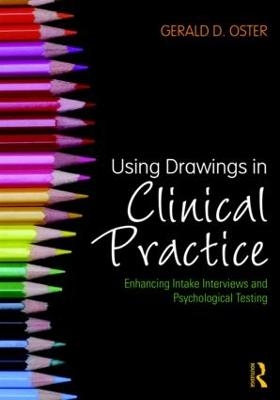
Using Drawings in Clinical Practice
Routledge (Verlag)
978-1-138-02406-9 (ISBN)
Clinicians are always in need of enticing techniques to engage clients on a daily basis, especially those who are nonverbal or initially opposed to feedback. Using Drawings in Clinical Practice provides a rich variety of drawing directives to enhance the diagnostic process. In this highly illustrated text, clinicians will discover the tools they need to interact effectively with their clients. The book places special emphasis on intake interviewing and psychological testing, where the potential for uncovering hidden conflicts and therapeutic direction is especially poignant. Case studies provide a comprehensive overview of how to introduce simple drawings and gain remarkable insights. Using Drawings in Clinical Practice is a crucial guidebook for professionals who seek new ways to facilitate meaningful communication and interactions in their practice settings.
Gerald D. Oster, PhD, has worked in a variety of inpatient and outpatient settings for more than 35 years. He is currently providing therapy and assessment services in private practice; he also supervises graduate students in psychological testing. In the past, he held the titles of clinical associate professor of psychiatry and psychology internship director. He has co-authored numerous books and professional publications, including Using Drawings in Assessment and Therapy: A Guide for Mental Health Professionals.
Chapter 1: DRAWINGS IN EVERYDAY PRACTICE
Case study – Sarah E.
Using drawings in clinical settings
Why use drawings?
Case study – Cheyenne R.
Drawings can be reassuring
Case study – Paul K.
Case study – Alice W.
Strengthening insight and problem solving
Disclosing temperament
Case study – Sam K.
Identifying goals and motivation
Talking through images
Vital points
Expansion of interpersonal engagement
Stimulating inspiration
Case study – Marcia T.
Concluding remarks
References
Chapter 2: FOUNDATIONS OF CLINICAL DRAWINGSHistorical aspects of clinical drawings
Images of psychological maturation
Developmental sequences
Cognitive maturation
Case study – Paul B.
Emotional indicators
Case study – James D.
Symbols of mental illness
Freud and Jung
Creative pursuits in psychotherapy
Case study – Elizabeth G.
Art therapy as a discipline
Interactions of art therapy and psychology
Case study – Lakandra F.
Case study – Charlotte P.
Controversies in drawing interpretation
From psychology to art therapy assessments
Silver drawing tests
Diagnostic drawing series
The person picking an apple from a tree
Enhancement to assessment
Cautionary tales
Concluding comments
References
Chapter 3: HOUSE-TREE-PERSON AND VARIATIONSHuman figures and everyday objects
House-Tree-Person
House drawings
Case study – Keli R.
Case study – Karl C.
The tree
Case study – Sakura R.
Case study – Sierra A.
Human figures
Case study – Joseph S.
Case study – Melissa B.
Case study – Monique W.
Kinetic house-tree-person
Case study – Mandy S.
Draw-a-person-in-the-rain
Case study – Toni N.
Family drawing procedures
Draw-a-family
Case study – Marla B.
Kinetic-family
Case study – Arlene G.
Family-centered-circle
Case study – Eddie C.
Mother-and-child
Case study – Alice W.
References
Chapter 4: ALTERNATIVE DRAWING DIRECTIVESBroadening the interpersonal encounter
Timelines
Case study – Lauren F.
Genograms
Case study – Nosian H.
Family shield
Case study – Albert J.
Draw your world
Case study – Amku L.
Draw yourself with friends
Kinetic school drawings
Case study – Kesandra B.
Draw your "ideal" self
Case study – Carla S.
Draw your (current) mood
Case study – Consuela L.
Defining and resolving problems
Case study – Alysha G.
Before, during, and after crises
Case study – Loren Y.
Ending remarks
References
Chapter 5: USING DRAWINGS DURING CLINICAL INTERVIEWSInformation gathering
Case study – Jacob D.
Conducting an initial interview
Case study – Lori S.
Behavioral observations
Case study – Eduardo L.
Case study - Randall M.
The crux of the interview
Types of clinical interviews
Intake interviews
Case study – Marilyn C.
Mental status exam
Case study – Breanna P.
Trauma interviews
CAPS
Case study – Kienna T.
Trauma symptom inventory
Case study – Nina F.
Trauma symptom checklist for children
Case study – Leyanna G.
Sexual abuse indicators in drawings
Case study – Louis T.
Benefits and limitations
Case study – Cheryl N.
Family evaluations
Sharing of conflicts
Case study – Jason A.
An enhancement to practitioners
References
Chapter 6: COMPREHENSIVE PSYCHOLOGICAL EVALUATIONS
Case study – Max T.
Case study – Janette B.
Psychological testing within the assessment process
Requests from treating professionals
Case study – Carlos B.
Responding to referral questions
Case study – Malcolm S.
Identifying presenting problems
The role of psychologists
Case study – Deborah M.
Case study - Charles L.
Puzzles that need solutions
Principles of psychological testing
Components of psychological evaluations
Selecting a test battery
Intellectual assessment
Academic achievement
Neuropsychological testing
Personality measures
Behavior rating scales
Projective techniques
Drawings in the test battery
Case study – Janice L.
Case study – John R.
The psychological report
Summaries of psychological evaluations
Marvin S.
Allison T.
Closing words
References
| Erscheint lt. Verlag | 17.2.2016 |
|---|---|
| Zusatzinfo | 59 Line drawings, black and white |
| Verlagsort | London |
| Sprache | englisch |
| Maße | 178 x 254 mm |
| Gewicht | 362 g |
| Themenwelt | Sachbuch/Ratgeber ► Gesundheit / Leben / Psychologie |
| Geisteswissenschaften ► Psychologie ► Klinische Psychologie | |
| Geisteswissenschaften ► Psychologie ► Test in der Psychologie | |
| Medizin / Pharmazie ► Medizinische Fachgebiete ► Psychiatrie / Psychotherapie | |
| Medizin / Pharmazie ► Physiotherapie / Ergotherapie ► Ergotherapie | |
| Sozialwissenschaften ► Soziologie | |
| ISBN-10 | 1-138-02406-6 / 1138024066 |
| ISBN-13 | 978-1-138-02406-9 / 9781138024069 |
| Zustand | Neuware |
| Haben Sie eine Frage zum Produkt? |
aus dem Bereich


